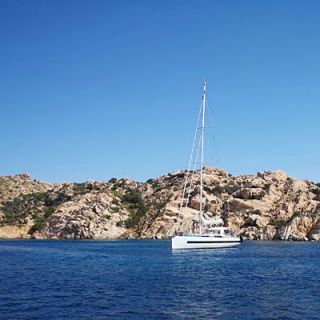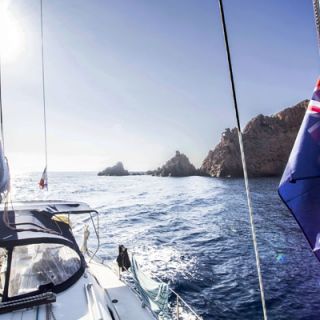A Fleeting Sailboat Tour in Corsica and Sardinia
Following our week of sailing the French Riviera on our 2018 charter familiarisation, we sailed an uneventful passage from Villefranche-sur-Mer to Corsica; a 95 nautical mile passage to the port of Calvi our most convenient arrival point. We had nine days to deliver our boat to its Ajaccio base. That would give us just enough time to explore Corsica’s west coast and visit northern Sardinia, as long as we kept moving.
Planning a Corsican Charter Sailing Holiday
Visiting Corsica, there are various options that include its best attractions in a charter sailing itinerary. A week’s charter out of Ajaccio, Corsica’s largest city, opens the island’s west coast, including Calvi, for exploration, but to travel further in seven days would be ambitious.
From Propiano to the south, Bonifacio, Porto-Vecchio and Sardinia’s lovely Maddalena archipelago are within easy reach. In reality, a visit to Corsica is most commonly added onto an Italian charter going the other way. This popular holiday option holiday starts in Olbia, Portisco or Cannigione in Sardinia’s northeast, sails through the Maddalenas and includes the southern Corsican ports and beaches.
As a complete alternative, embark in Tuscany for Elba and the rest of the Tuscan Islands, and the Corsican ports of Bastia and Maccinagio come within reach. More intrepid charterers on a longer cruise in this region have the option of sailing around the top and down to Saint Florent and Calvi.
Any Italian charter is greatly enhanced by including Corsica where possible. It would take a two-week charter to sail right around the French island, and after our recent visit we would recommend it if time is available. As with this trip of ours, there is often the opportunity to deliver a boat one-way from or to the mainland. That provides even more itinerary possibilities. But to do Corsica justice takes longer than the time we had.
Impressions of Corsica: A Rugged Land of Conflicts Past
So let’s get back to our own Corsica charter experience. The high mountains of northern Corsica present a faint outline in the sky when still some 30 miles from shore with only the heat haze preventing it being seen much further out. It’s an impossibly rugged terrain that defies human habitation. But inhabited it has been for millennia. There’s abundant history and prehistory to be studied if the time’s available to explore.
Calvi is a vibrant town with all manner of shops, restaurants and tourist resorts. The Citadel of Calvi sits high on the headland overlooking the large bay to its north. This is a fine example of a mediaeval fortification. The walled city within still serves as private residences, and it’s not overrun with restaurants. They can be found in abundance down in town.
The anchorage at Calvi provides mooring buoys and marina berths at reasonable prices. We’d departed the French coast at 5.00am to make sure we would not be arriving at an unknown port in failing light. We found this is an easy anchorage to access, and had we arrived later there would have been no problem finding safe haven for the night.
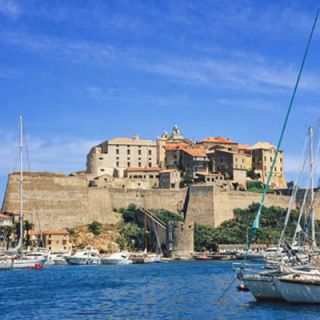
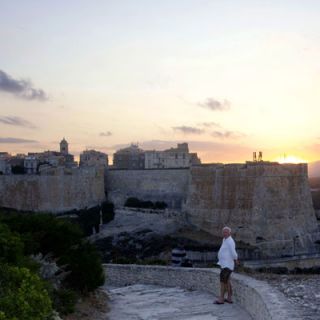
Heading south from Calvi the landscape is unrelentingly steep. Some 15 miles down the coast we came to the Scandola nature reserve. A large section of this coast is set aside as reserve, and only daytime anchoring is allowed. The quiet and secluded rocky bays with crystal clear water are lovely picnic stops for a swim and a short walk. Perhaps check out a Genoese tower, a structure that soon becomes very familiar in Corsica.
Cruising Under Motor along the Western Shore
After a swim and a meze of fine French tastes, we motored along this impressive coast past headlands with Genoese towers perched in impossible places. On every prominent headland in Corsica one of these small round castles was built. The inhabitants were armed with catapults to lob heavy objects and scalding water at invading attackers, mainly Turks and marauders from northern Africa. How the Genoese occupiers built them is truly fascinating considering the landscape. They constructed some 100 before deciding around 1620 that it was too hard to defend the Island any longer, leaving for the locals to survive under a period of self-rule.
When Napoleon decided to have a crack at claiming his place of birth in the name of France, he noted the effectiveness of these structures. The British also had a go at conquest, and were so impressed they replicated them as the Martello towers they are called elsewhere.
Our first overnight stop was at Girolata, its harbour nestled in the cliffs and settlement on flat land at the head of a sheltered bay. The set-up here is mostly moorings with a stern line to hold the bow to any motion that enters the bay.
On this part of the coast as far as Ajaccio expect a swell at night, not large but enough to make life on an anchored monohull a bit unpleasant.
Along this more exposed stretch of coastline there are sandy beaches, some of the best to be found in the Mediterranean. For any stopovers here, I recommend beaches by day and marinas by night, or take a catamaran, in which case the swell is not such an issue. Most beaches have a cafe or two that are well patronised by locals. Development in this region is tasteful and the lifestyle very alfresco. The resorts are usually set back from the beaches if there are any at all; many have little or nothing in the way of development, making some of the best spots feel quite remote.
Cargèse and Sagone are ports to stop for the night. Cargese has a marina and Sagone, at the head of a large bay, has moorings for use with stern line to spend the night in comfort. I would love to talk more about these ports, but apart from enjoying the beaches we kept going all the way to Propriano.
Passing bays along the way that would provide shelter from the NW swell with conventional anchoring, we came to Propriano with its modern marina. This is a good place to take an excursion and explore inland. Several bus tours visit a variety of ancient sites, some of which are pre-historic.
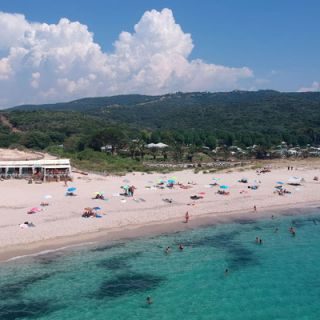
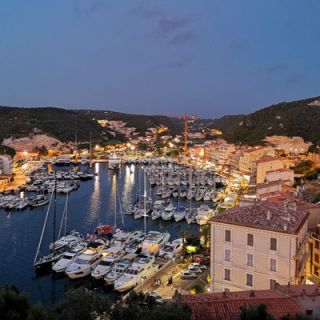
Where Corsica and Sardinia Meet
Heading to Bonifacio we passed numerous bays tucked behind headlands. Finding port was somewhat of a surprise and if it were not for the chart plotter I would not have believed there was safe harbour tucked within the white cliffs. But indeed, a narrow entrance opens up to what many describe as the most beautiful harbour in the Mediterranean. The Citadel of Bonifacio on the hill is well restored and bustling with traders and restaurants.
To berth in Bonifacio requires booking ahead. There are ways to do this and practices to follow, which we explain in detail before charter.
By now we were into a predominantly Sardinian charter itinerary as it's just five miles across to Italy. But before heading there, we ventured further around to Porto-Vecchio. On the way are a series of sheltered anchorages and beautiful coves in a sparsely populated region that is undeveloped for tourism: ideal for the cruising yachtsman.
Porto-Vecchio offers a marina and moorings, or just lay at anchor a bit further out. This is a bustling centre of activity with an airport and a lot going on ashore. The old town is quaint and well worth a walk around.
On a two-week itinerary we’d have visited Sardinia first and kept going up this coast, putting a large day in to sail 60 or so miles up to Bastia or Elba and the Tuscan islands. On this trip schedule however, we needed to turn back rather than go all the way around and head for the Maddalena Islands. We bypassed Cavallo Island (France) which we were warned is quite expensive.
The first set of Italian islands we came to are a series of low-lying, uninhabited and barren rocks, clearly popular as a place to stop for the day in any of several sheltered spots. Being here in late July, peak holiday season, there were boats everywhere it was good to go. But with plenty of space we had no issues finding an anchorage or marina when we wanted one.
A Pleasant Stay in Arcipelago di La Maddalena National Park
The day we crossed the Strait of Bonifacio was our first sailing day since arriving in Corsica. In a region notorious for strong winds, we were enjoying a passive 10-15 knot breeze on our aft quarter. We meandered pleasantly through the Maddalena archipelago until the limitations of being under sail started to interfere with our need to explore.
To be in Maddalena National Park requires a permit. Once in there are plenty of places to anchor for free, or to pay for a mooring. In Italy it always pays to know in advance what a mooring or marina will cost, as prices can vary considerably. As for navigation around the Maddalenas, I must emphasise that regular reference to the chart plotter is essential due to unmarked rocks
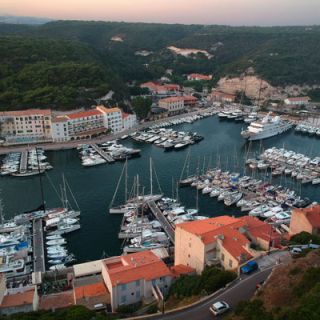
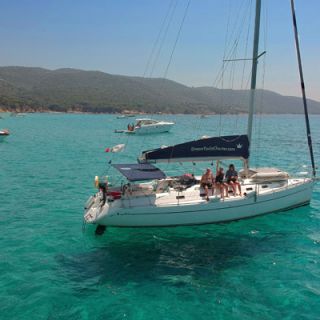
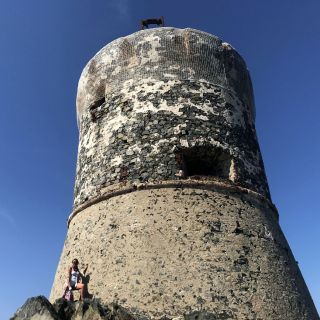
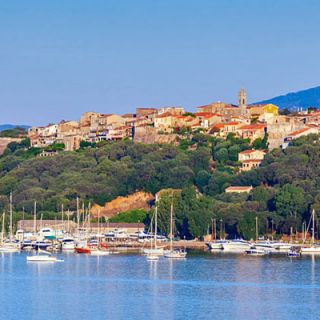
There is a lot to this part of Sardinia, and a one week charter can easily be used up among these islands and the adjacent mainland. We anchored for the night in a sheltered inlet on the main La Maddalena Island, and next morning continued to explore. We anchored for lunch in a still bay on the south side of Caprera Island, at around which time the wind was starting to pick up. It continued to gather strength under a cloudless blue sky until about 6.00pm, at which time it was touching 30 knots. By then we were safely in Cannigione marina, while plenty of boats were still out revelling in the conditions of wind and flat sea and having a great sail.
By dinner time the wind had gone and we enjoyed a very pleasant time ashore, shopping genuine Italian-quality but good-value items at the Cannigione market, then on to eat an Italian pizza, in Italy!
Mainland Sardinia and Journey’s End at Ajaccio
The marinas in Sardinia take some getting used to. They all appear to be privately owned, and in Cannigione it appeared that each finger has a different owner. And so we were greeted by boat owners with waving arms trying to lure us into particular berths. Outside of the marina we could have easily anchored for free, but I needed to experience at least one marina stay in Italy. Cannigione is also a base for many of the fleets we represent, and there were people I wanted to say ciao to.
The following day we explored along a coastline dotted with beaches, small towns and resort settlements. We liked it a lot. It’s hard to say why certain places appeal, but that is why one must go there - to find out. .
We had two days left on our charter, so the next day we headed back out into the Strait of Bonifacio, that stretch of water renowned for its strong winds. As it was, we motored over glassy seas for the better part of the day, eventually stopping at one of the many sandy Corsican beaches for a swim. Then on to Ajaccio, arriving a day early to see the town, and to catch up with base representatives of companies we work with.
Reflecting on this two-week itinerary, starting in Toulon and going west along the Provence coast, then east along the Cote d’Azur, then on to Corsica and Sardinia, it was non-stop but a thoroughly memorable experience.
Two weeks for that was a crazy pace. Any one of these four regions we could easily have taken a week to enjoy.
I liked Italy a lot, but I loved France!
